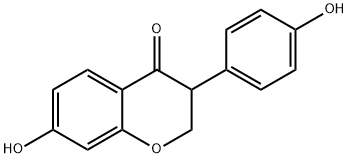Dihydrodaidzein
- CAS NO.:17238-05-0
- Empirical Formula: C15H12O4
- Molecular Weight: 256.25
- MDL number: MFCD00210494
- SAFETY DATA SHEET (SDS)
- Update Date: 2024-11-20 11:41:24

What is Dihydrodaidzein?
Chemical properties
Light Beige Needles
The Uses of Dihydrodaidzein
Daidzein is an isoflavonoid phytoestrogenic compound found in soybeans, pea pods, clover, kudzu, and other legumes. Dihydrodaidzein is an active, estrogenic metabolite of daidzein. It has vasodilatory action on rat isolated aortic rings at 1 μg/ml. It stimulates the estrogen receptor-dependent growth of breast cancer MCF-7 cells at micromolar concentrations. Dihydrodaidzein is produced by the metabolism of daidzein in colonic bacteria and may be further metabolized to various bioactive compounds, including equol .
The Uses of Dihydrodaidzein
A metabolite of Daidzein.
What are the applications of Application
Dihydrodaidzein is a metabolite of Daidzein
Definition
ChEBI: A hydroxyisoflavanone that is isoflavanone carrying two hydroxy substituents located at positions 4' and 7.
Biological Activity
dihydrodaidzein, an active, estrogenic metabolite of daidzein in colonic bacteria, probably is further metabolized to various bioactive compounds including equol. as an estrogen receptor agonist, dihydrodaidzein, at micromolar concentrations, activates the estrogen receptor-dependent growth of breast cancer cells. daidzein, an isoflavonoid phytoestrogenic compound, is found in soybeans, clover, kudzu, and other legumes.
in vitro
prostatic fluid and plasma concentrations of dihydrodaidzein were sufficient to block the growth of benign human prostatic epithelial cells (prec). dihydrodaidzein showed a significant inhibitory effect on the growth of prostate cancer cell line lncap. additionally, dihydrodaidzein slightly triggered the apoptosis of prec. in addition to affecting apoptosis, dihydrodaidzein decreased proliferation, which was associated with the changes in cell cycle distribution and caspase 3 activation [1].
in vivo
male c57b1/6 wild type mice were administered orally with dihydrodaidzein at a dose of 25 mg/kg/day for 4 weeks. compared to the control groups, the neointima of mice treated with dihydrodaidzein was thickened. in dihydrodaidzein-treated mice, the intimal thickness in the non-injured right iliac artery was not altered. moreover, neointimal proliferation was selectively blocked by dihydrodaidzein via suppressing the migration and proliferation of vascular smooth muscle cell and dampening the endothelial apoptosis [2].
References
[1]. hedlund, t., bokhoven, a., johannes, w., nordeen, s., & ogden, l. prostatic fluid concentrations of isoflavonoids in soy consumers are sufficient to inhibit growth of benign and malignant prostatic epithelial cells in vitro. the prostate. 2006; 66(5): 557-566.
[2]. shen, j., white, m., husband, a., hambly, b., & bao, s. phytoestrogen derivatives differentially inhibit arterial neointimal proliferation in a mouse model. european journal of pharmacology. 2006; 548(1-3): 123-128.
Properties of Dihydrodaidzein
| Melting point: | 250-251°C |
| Boiling point: | 529.5±50.0 °C(Predicted) |
| Density | 1.386±0.06 g/cm3(Predicted) |
| storage temp. | -20°C Freezer, Under Inert Atmosphere |
| solubility | ≤0.1mg/ml in ethanol;30mg/ml in DMSO;10mg/ml in dimethyl formamide |
| form | powder to crystal |
| pka | 7.71±0.40(Predicted) |
| color | Light orange to Yellow to Green |
| λmax | 313nm(EtOH aq.)(lit.) |
| CAS DataBase Reference | 17238-05-0 |
Safety information for Dihydrodaidzein
| Signal word | Warning |
| Pictogram(s) |
 Exclamation Mark Irritant GHS07 |
| GHS Hazard Statements |
H315:Skin corrosion/irritation H319:Serious eye damage/eye irritation |
| Precautionary Statement Codes |
P264:Wash hands thoroughly after handling. P264:Wash skin thouroughly after handling. P280:Wear protective gloves/protective clothing/eye protection/face protection. P302+P352:IF ON SKIN: wash with plenty of soap and water. P305+P351+P338:IF IN EYES: Rinse cautiously with water for several minutes. Remove contact lenses, if present and easy to do. Continuerinsing. P332+P313:IF SKIN irritation occurs: Get medical advice/attention. P337+P313:IF eye irritation persists: Get medical advice/attention. |
Computed Descriptors for Dihydrodaidzein
New Products
Tert-butyl bis(2-chloroethyl)carbamate 4-Methylphenylacetic acid N-Boc-D-alaninol N-BOC-D/L-ALANINOL 3-Morpholino-1-(4-nitrophenyl)-5,6-dihydropyridin- 2(1H)-one Furan-2,5-Dicarboxylic Acid Tropic acid DIETHYL AMINOMALONATE HYDROCHLORIDE 1,1’-CARBONYLDIIMIDAZOLE R-2-BENZYLOXY PROPIONIC ACID 1,1’-CARBONYLDI (1,2-4 TRIAZOLE) N-METHYL INDAZOLE-3-CARBOXYLIC ACID (2-Hydroxyphenyl)acetonitrile 4-Bromopyrazole 5-BROMO-2CYANO PYRIDINE 5,6-Dimethoxyindanone 5-broMo-2-chloro-N-cyclopentylpyriMidin-4-aMine 2-(Cyanocyclohexyl)acetic acid 4-methoxy-3,5-dinitropyridine 2-aminopropyl benzoate hydrochloride 1-(4-(aminomethyl)benzyl)urea hydrochloride diethyl 2-(2-((tertbutoxycarbonyl)amino) ethyl)malonate tert-butyl 4- (ureidomethyl)benzylcarbamate Ethyl-2-chloro((4-methoxyphenyl)hydrazono)acetateRelated products of tetrahydrofuran








You may like
-
 Dihydrodaidzein CAS 17238-05-0View Details
Dihydrodaidzein CAS 17238-05-0View Details
17238-05-0 -
 1975-50-4 98%View Details
1975-50-4 98%View Details
1975-50-4 -
 2-HYDROXY BENZYL ALCOHOL 98%View Details
2-HYDROXY BENZYL ALCOHOL 98%View Details
90-01-7 -
 2-Chloro-1,3-Bis(Dimethylamino)Trimethinium Hexafluorophosphate 221615-75-4 98%View Details
2-Chloro-1,3-Bis(Dimethylamino)Trimethinium Hexafluorophosphate 221615-75-4 98%View Details
221615-75-4 -
 61397-56-6 CIS BROMO BENZOATE 98%View Details
61397-56-6 CIS BROMO BENZOATE 98%View Details
61397-56-6 -
 14714-50-2 (2-Hydroxyphenyl)acetonitrile 98+View Details
14714-50-2 (2-Hydroxyphenyl)acetonitrile 98+View Details
14714-50-2 -
 118753-70-1 98+View Details
118753-70-1 98+View Details
118753-70-1 -
 733039-20-8 5-broMo-2-chloro-N-cyclopentylpyriMidin-4-aMine 98+View Details
733039-20-8 5-broMo-2-chloro-N-cyclopentylpyriMidin-4-aMine 98+View Details
733039-20-8